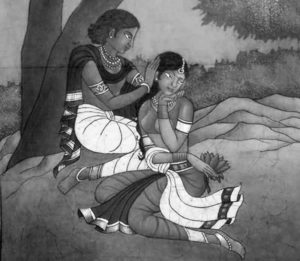We shall now go back in time by nearly two thousand years. Behold! Godavari flows in a mellifluous melancholic tune. Swaying the entire countryside near Pratiṣṭhāna[1] to the graceful swinging of her waves, as she gushes on, yearning to rendezvous with her beloved, the Eastern Ocean. That is indeed why her valleys are dotted with dense reeds and canes – signifying the frequent haunts of passionate young lovers. Above that, beyond the banks, the thick growth of Burflower and Kadamba trees, along with the fragrance-laden thicket of Jasmine and Ketaki creepers have found fulfilment by creating an excellent ambience as the pleasure gardens of unrestrained lovers. Even the fauna here, like birds and deer, exhibit so much concern for the secret love of the daring young lovers! They seem to consider it their great privilege to offer timeless protection and sustenance for their patrons’ clandestine encounters to flourish. If not, lo and behold! A lone crane perched so still on a lotus leaf, like a conch placed on an emerald tray – why would it suggest to the young couple that just went by, that the thicket here is the best spot for their amorous meet? Look here, how these parrots arise like a string of emeralds and corals adorning the neckline of the Sky Goddess! Who could possibly be unmoved by such a sight! Look at the row of white birds flying across the dark monsoon clouds! Doesn’t it look like a casual stroke of chalk scribbled by Father Time wondering where the Sun and Moon disappeared? In what choicest terms should we chide the wayfarers who, at such an hour, have not yet returned to the warm arms of their beloveds? Oh, the relentlessly pounding rain here! It appears as though the elephant-like-clouds are on a mission to draw up the Earth to the Skies using the chains of rainwater! Come to think of it, this heavenliness is not to be found even in Paradise! This region is ensconced in the lap of the Vindhya mountain range. The Vindhya peak, darkened by the forest fires, rising amidst the fair early-autumn clouds, resembles Viṣṇu sprinkled with droplets of the milk-ocean’s waves. The pellucid lakes here, like the hearts of the virtuous, exude warmth outside and yet retain coolness inside; always pleasing to those who take delight in sporting in waters. In the shrubs near the water… O! What could be the matter – the birds are chirping and flying about excitedly! Ah, but of course! They are announcing that the village chief’s dear daughter has just made her love-debut with a charming young farmer from the same village! Oh, the beauty of winter in this locale! The dew drops lingering on the tip of the lush green blades of grass look like pearls strung on emerald needles. The proud curves that are the necks of the peacocks imbibing this dew essence are simply delightful. Here, here look! The beautiful blossoms of the forest flame tree.[2] The colour and arc of its half-blooms verily look like the nail-marks of intimacy borne by the forest feminine, gifted by her lord, Spring – the king of seasons. The flowers lying on the ground look like the bright-red-robed Buddhist mendicants prostrating in veneration at the feet of the Buddha. Young beetles mistakenly drawn to the pungent aroma of Bel fruits relentlessly hum and circle them, like beguiled children trying to grasp at the pictures of sweets. Even wayfarers are not immune to this kind of delusion. While approaching a dried-up banyan tree from afar, they happily confuse the parrots perched on it for young leaves. Upon coming closer, however, they realize the truth, and clap with a merry laugh at their own imagination, causing the pandemonium of parrots to launch up, as if they were commissioned to prepare the most verdant lawn at the base of the skies! Even the wildlife of this region is well-versed in love lore. For instance, this bull elephant, despite being famished and having an inviting stream brimming with sparkling lotuses staring right at him, isn’t tempted to feast on the tender lotus stems. This is because he is wistfully lost in the memory of his mate. Poor thing! The stem he drew up with his trunk, in the meanwhile, has dried up. The does in this forest are more innocent than the damsels of our village. Otherwise, would they stare without blinking at a forest fire, mistaking it for a grove of forest flame trees? Now look at the onset of twilight here, on the reddish fringe of the sky. Doesn’t the two-day-old crescent moon there look intoxicating, appearing like a nail-mark on the bosom of Lady West? What’s more, don’t the black bees thronging the fair water-lilies seem like darkness itself mopped up by the moonbeams? In a nutshell, this entire belt is brimming with love. If the nature here is thus, what can one say about the culture of this realm?
The people here are rustic, but not inane. They are refined, sensitive, and are keenly perceptive of things left unsaid. Despite not being formally initiated, they are adroit in the practical applications of poetry. In the matters of love, they are neither prudish nor wanton. They are but urbane villagers. The suave womenfolk here adorn their ample breasts, which resemble the life-and-abundance-symbolizing golden kalaśas[3], with beautifully ornate and fragrant drawings, as they ceremoniously receive their homecoming men. The men here are not ones to be left behind; they are incurable romantics who find separation from their lovers to be so unbearable that love-sickness causes them to become bed-ridden.
Enough with the introduction. Come, let us take a look at the many boats sailing down this town’s river of love, and set sail alongside them. First let us observe the romances and conflicts in the domestic realm. Look here! A young entreating husband, after desperate attempts to woo—in a variety of ways—his wife, who is miffed with him for some reason, has finally given up and fallen at her feet. Their two-year-old toddler, unperturbed by all this, innocuously climbs on to his father’s bent back, for ‘horse-riding.’ Needless to say, the annoyance of the homemaker readily gave way to mirth and laughter! In another home, the man of the house, looking at his beloved wife’s futile attempts at lighting the kitchen stove using a blow pipe that have left her red-eyed, remarks: “O, don’t do that, dearest. Looks like Agni has taken fancy to the kiss of your breath and is raising smoke all around, hoping for more!” In yet another dwelling, during kitchen-work, the wife happened to slightly smudge her face with her sooty fingers. Her doting husband teased her saying, “Well, now, your face is indeed comparable with the moon!” In another household, sensing that her brother-in-law has evil designs on her, the new bride has taken to paint the story of Lakṣmaṇa on the wall, to awaken his conscience. Worse than this, elsewhere in this town, is the plight of another chaste woman facing a similar predicament! This woman is neither able to apprise her quick-tempered husband of this situation nor sufficiently strong-willed to raise a squabble in the household. She has silently resigned to her cruel fate and is increasingly becoming frail. Moving on, we now see a poverty-stricken woman living in a shanty. Her husband whom she greatly adores is out of town and she’s home-alone. Unfortunately, she has for neighbours, a bunch of two-timing women. Despite this, she has resolutely remained true to her husband who is away. In yet another part of the town is a woman who is also pining for the return of her dear husband who is travelling. Luckily for her, the lady next door is so sensitive and kind-hearted that out of concern for her forlorn friend, she intentionally refrains from decking herself up, despite having to honour her own planned romantic commitments. She does this so that her sullen friend may stay true to her love and not succumb to temptations!
Next we see a girl from an affluent family, who has married by conscious choice, a young man of meagre means, but rich in cultural graces. When the occasion calls for it, she doesn’t hold back from liberally chastising her smug relatives visiting her house, in strong defence of her husband’s cherished self-esteem! Now let us move our focus elsewhere. Here’s a clever adulteress making overtures to a handsome young passer-by, addressing him thus: “In this scorching sun, where even shadows have come to attach themselves to the base of the trees, why don’t you come in and make yourself at home?” Next we see a brave woman who confesses to her mother-in-law thus: “My mind is not satiated no matter how much I feast my eyes on him. Will thirst be quenched if one drank water to one’s fill, but in a dream?” Our next character is an ill-fated young woman whose family members have been slain in cold blood. The apprehended culprit is a young man. As he is being taken away to prison, despite being grief-stricken, our young woman stares at him, awestruck by his comely features! After all, why begrudge a good quality? Elsewhere, a woman tells her mother-in-law that all forms of love are but shams; her logic is: “If love indeed were true, how could such a cruel thing as separation even exist? Even if it did and such a calamity was to strike, how could lovers ever hope to survive it?” Now let us see the way a messenger relays back her friend’s pangs of separation to her lover. Says she: “O gentlemanly lover! I conveyed your message to her; not once, but ten times. Even then, apparently not fully comprehending its essence, she made me repeat it a hundred times over, savouring your missive to the fullest.” Look here now! An overjoyed wife is showing her discerning husband the Jujube fruit bearing the bite-mark made by the tender teeth of their first born! Next we see a lady messenger convey her friend’s precarious situation to her lover who has many girlfriends; she says, “In order to find refuge in your heart, which you have so generously made available to several women, my crestfallen friend is becoming frail by the day. In such cramped quarters, how else could she hope to find room?” Meanwhile, we see an audacious piece of advice given by a woman to her friend: “O pretty one! Why do you struggle so, trying to surreptitiously steal a glimpse of that young man? Worry not. Go on, ogle at him to your heart’s content. The onlookers would only come to think of you as naïve!”
To be continued.
This is the first part of an English translation of a remarkable Kannada essay by Śatāvadhāni Dr. R Ganesh titled ‘Gāhāsattasaī’ya Amaraśṛṅgāra from his anthology Hāsu-bīsu. The translators would like to express their heartfelt thanks to Dr. Ganesh for his detailed review of the translation. Thanks to G S Raghavendra for his kind review and valuable suggestions.
Footnotes
[1] Modern-day Paithan; near Nasik, Maharashtra. [2] Butea frondosa. [3] Kalaśa can refer to a round jar, water-pot, or pitcher.


















































